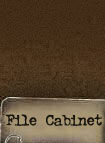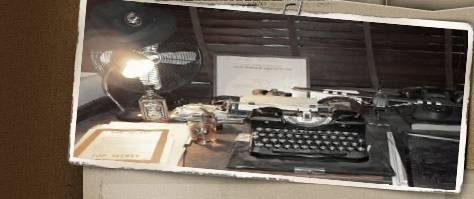|

File No.: Battle Relic # 32
Title: "World War Two British
Despatch Rider Helmet found in
Eindhoven"
Investigation made at: The
Netherlands
Period Covered: 18SEP1944 -
14APR2022
Date: 10AUG2022
GPS Location: 51°26'10.1"N
5°28'59.0"E
Case Classification:
Description of a World War Two
British Steel Despatch Rider Helmet
Case Status: Case Closed |
(click to enlarge)
.JPG) |
REASON FOR INVESTIGATION:
On 19APR2022 this agency received
information from the Municipality of
Eindhoven that during renovation of
a crossroads in the center of the
city a British Helmet of WW2 was
found on Oude Stadsgracht ("Old City
Moat").
City Archeologist Peter de Boer
wrote to us:
"As you have likely noticed, the
city is working on the redevelopment
of the midtown area (replacement of
sewage systems and refurbishment of
the public space). This is combined
with Unexploded Ordnance Disposal
(the IDDS Explosives company) and
archeological research (the BAAC
company). During research a British
paratrooper helmet was found in the
filling of the muted city moat
(location Oude Stadsgracht). It will
be conserved as an archeological
discovery and will therefore be kept
in the archeological depot. During
[earlier city projects] you have
indicated that you’d appreciate
being kept in the loop about these
kinds of finds. Well, here it is! I
haven’t held the item myself and
therefore don’t know if the hole is
a bullet hole or if it has simply
rusted through. It has been
determined as British but […]
reading about Market Garden only
American airborne troops of the
101st would have been deployed
around Eindhoven? Do you have an
explanation for this?"
This interesting discovery and our
efforts in describing it and
researching its likely history is
reported here. |
SYNOPSIS:
Attached to the city archeologist’s
e-mail were several photographs of
the helmet as it was upon discovery.
They show a round metal helmet shell
covered in dark soil consistent with
the matter that had been found on
nearby sites where the old city moat
used to be. Also during a recent
visit to the redevelopment site on
Oude Stadsgracht, prior to the
discovery of the helmet, we had
observed a pile of this black soil. |
|
|
|
(click to enlarge)
.JPG)
.JPG)
The helmet found on Oude
Stadsgracht in Eindhoven |
|
That same day we replied the
archeologist’s e-mail that "judging
from the shape of it, we conclude
that it is indeed a British helmet.
Whether it is a British paratrooper
helmet, official designation Helmet
Steel Airborne Troops (HSAT), we
can't determine however. The British
Army in World War Two had 3 types of
helmets with a round outer metal
shell: the HSAT helmet I mentioned
(and within that type, three
different sub-variants), the
despatch rider helmet and the tanker
helmet. Attached are a compilation
of 6 clippings from photos taken in Eindhoven on 18SEP1944; the day the
city was liberated by American
paratroopers and British troops of
30th Corps." |
|
(click to enlarge) |
|
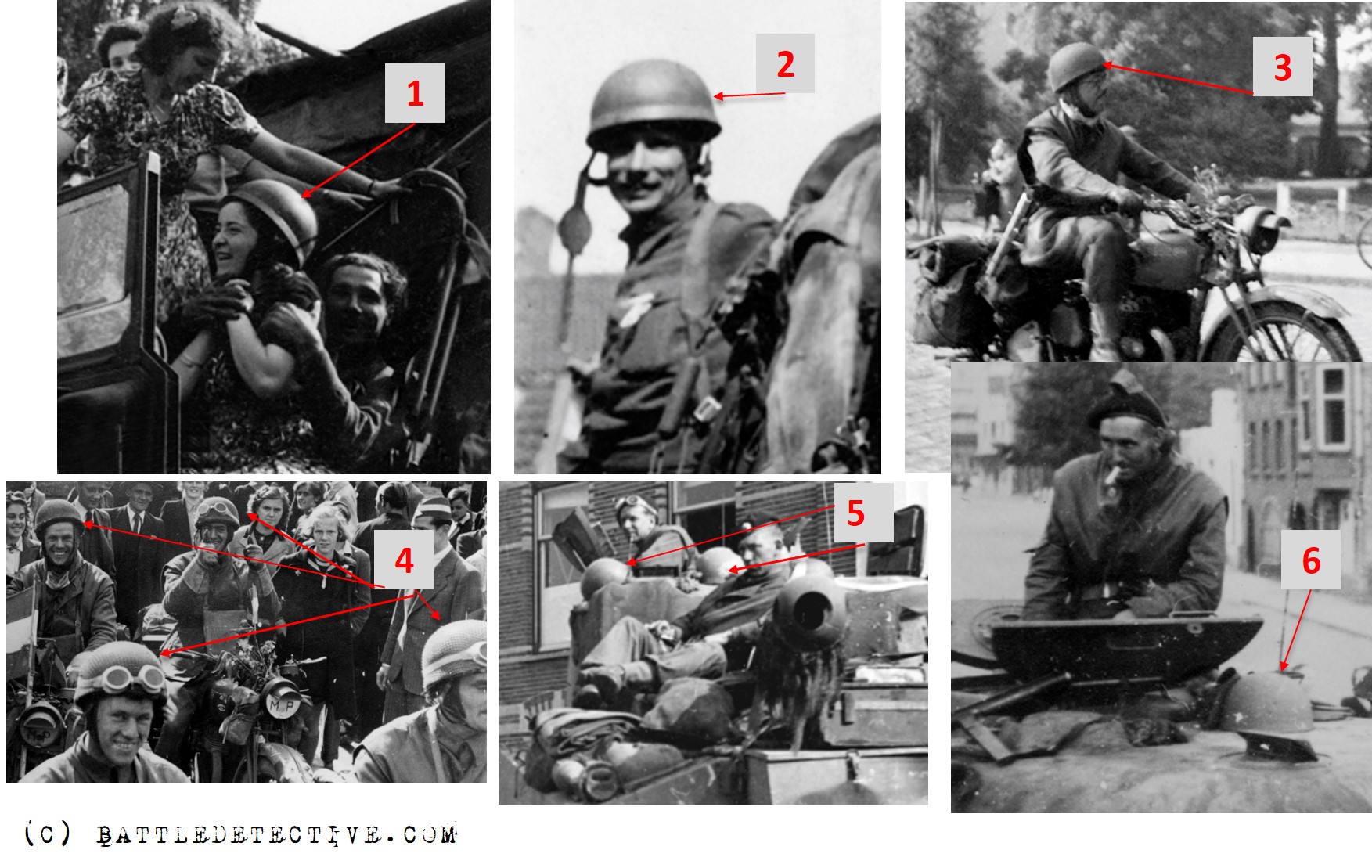
Clippings 1 & 2 show para
helmets, 3 & 4 are despatch rider
helmets and 5 & 6 are tanker helmets. |
The soldiers wearing paratrooper
helmets in Eindhoven belong to the
so-called “seaborne tail” of the
British 1st Airborne Division.
The majority of this division
airlifted to Arnhem by parachute and
gliders and these seaborne troops
traveled with the ground forces of
the operation to join their
division if Operation "Market
Garden" would develop as planned.
The despatch riders and tankers
belonged to units within 30th Corps.
The outsides of their helmets are
mostly identical; Its interiors
consisting of the linings and
chinstrap suspensions differ per
type and are unique.
We requested a photo of the inside
of the helmet telling that although
it appears damaged extensively, the
type of suspension of the interior
may render clues as to the specific
type.
The request was forwarded and on
21APR2022 Christian, Project Leader
/ Advisor Detection Unexploded
Ordnance of the IDDS Company wrote:
"Below is a photo of the interior of
the helmet in question. At this time
the helmet is in the hands of the
construction contractor and will be
transferred to the archeologists of
the BAAC company. If desired Sander
[of the BAAC company] can surely
help you if you wish to see the
helmet." |
|
(click to enlarge)
.JPG)
The interior of the helmet found
on Oude Stadsgracht in Eindhoven |
On 22APR2022 Sander, Project Leader
/ Quality Manager at BAAC, wrote: "I
have asked our archeologist René [of
the BAAC company] to inform you when
he is at the site to enable you to
come and see. I suspect that this
will be after next week. We will
then take the helmet to our office
quick in order to start the
preservation."
Investigative leads
While waiting for news from the BAAC
company we visited the construction
site on 25APR2022.
One of the workmen let us within the
fenced off site and stated that he
had been present when the helmet was
found on Thursday 14APR2022. He told
us that the helmet was found at
approximately 3 meters (9.8 ft) deep
in a former moat. He pointed to the
location where it was found and said
a British 25 pounder shell had been
found there also. On a mobile phone
he showed us
a photo of the primer
of the shell which had the year 1943
on it. |
|
(click to enlarge)

Workman pointing to spot where
the helmet was found |
|
On 12MAY2022 we visited the location
on Oude Stadsgracht again and met
René, Project leader Archeology with
the BAAC company. He told us that
during the preservation process, the
British helmet showed small jagged
saw tooth ("shark teeth" in his
words) elements on the inside. These
may be parts of the liner
suspension. He explained that the
helmet was found together with a lot
of debris of bricks which had been
used to fill in the moat that ran
along Oude Stadsgracht. Where the
moat crossed Stratumseind (Eindhoven's
"bar street") there used to be a
bridge. Later that day a World War
Two German helmet was found at the
site of where that bridge was, close
to its southern abutment. |
|
(click to enlarge)
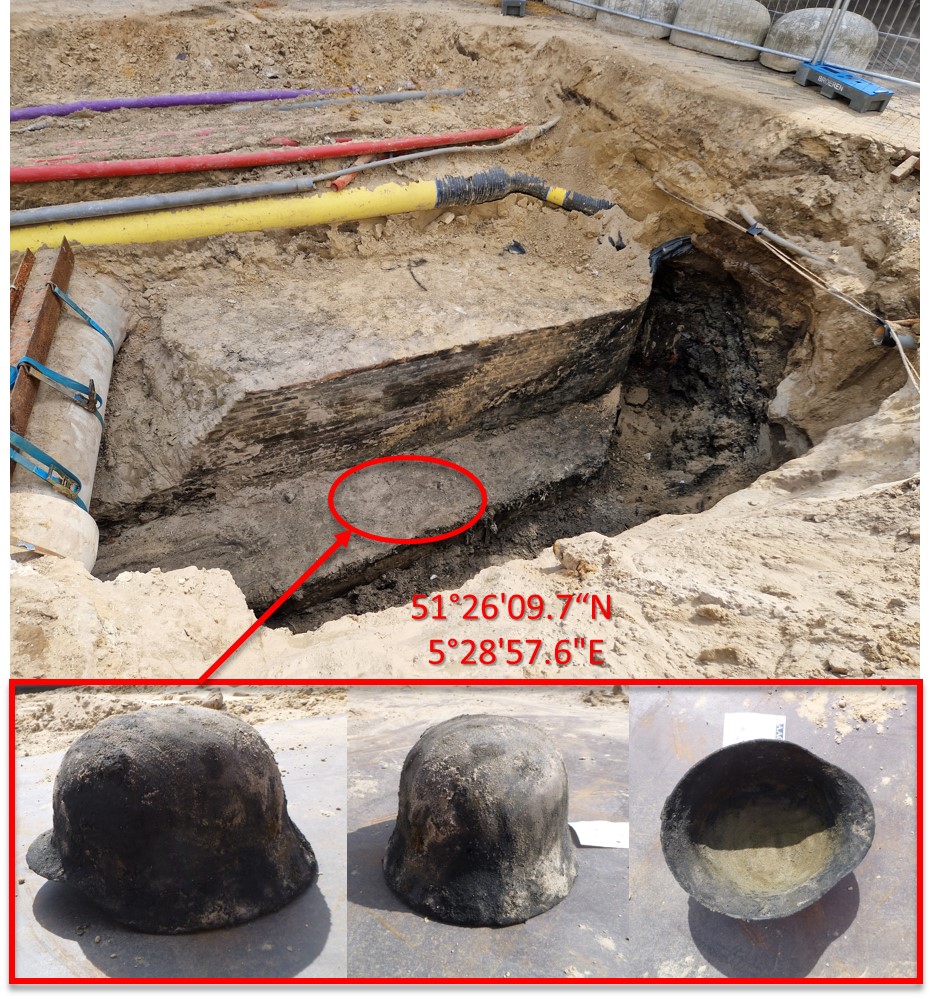
Location where the German helmet
was found on 12MAY2022 |
|
At the end of the day René provided
photos of that German helmet (shown
above) and
also of the exterior of the cleaned
British helmet: |
|
(click to enlarge)
  |
The location where the German helmet
was found paints a good picture of
the location where -and the
conditions under which- the British
helmet was dumped in the old city
moat. Unfortunately the excavation
and subsequent refurbishments of the
city’s sewer system is destructive
for the subterranean archive.
For example, a day later, on
13MAY2022 we found the bricks in the
abutment destroyed and on 16MAY2022
the former moat was filled with old
timber from times when it was still
in use.
A few days later the excavation site
was filled in with soil again.
|
|
(click to enlarge)
 1) 1)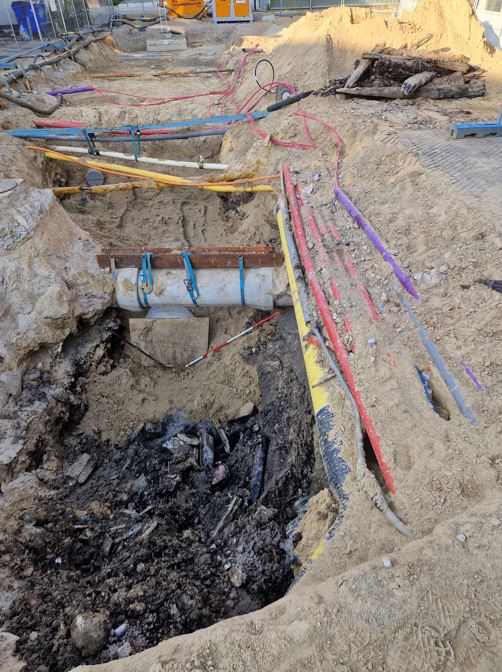 2) 2) 3) 3)
1)
Brick abutment destroyed on
13MAY2022
2)
Timber found in the former city moat
on 16MAY2022
3)
A concrete sewage hub with manhole
is installed and the moat filled in
with clean sand on 18MAY2022 |
HSAT, RAC & DR Helmets
As described, the British Army in
WW2 issued three types of round
steel helmets; the HSAT for
paratroopers and glider soldiers,
the RAC helmet for armored troops
and the DR helmet for motorcycle
riders.
Helmet Steel Airborne Troops
This combat helmet was worn by
paratroopers and members of
airlanding units. It was introduced
in WW2 by the British Army and was
also used by other Commonwealth
armies. It continued to be used
post-war until the early 1980's. As
with the similarly shaped RAC helmet
and despatch rider motorcycle
helmet, it was initially
manufactured by Briggs Motor Bodies
(BMB) at Dagenham.
The HSAT saw 4 different variants or
types:
P Type Helmet
The first prototype variant was used
during the Bruneval Raid on
27-28FEB1942. The first steel helmet
was produced by BMB in 1941 and it
is estimated that only 500 to a 1000
of them were made. This type,
sometimes referred to as the
"Bruneval Helmet" featured a
non-magnetic manganese steel shell
with a rubberized rim and a lining
with interior padding that was
similar to the German M36/40 design.
HSAT
The improved helmet was introduced
in 1942 featuring a similar shell
design, but with a thick vulcanized
fiber band rim that clearly
distinguishes it from the German
model, along with a four-point
leather chinstrap system and a band
of Sorbo rubber for padding.
HSAT Mk I
Third pattern featuring the same
leather chinstraps and a steel rim
instead of the fiber rim. Issue
started in OCT1942.
HSAT Mk II
Fourth pattern featuring the
three-point webbing chinstrap. This
variant was also used after WW2, and
was phased out around the time of
the Falklands War.
Telltale signs for this type of
helmet are the larger holes to
accommodate screws that can be used
to adjust the leather chinstraps in
the 10 and 2 o’clock positions the P
and all HSAT types.
The HSAT Mk I and Mk II helmets
typically feature a single screw at
the 6 o’clock (neck) position whereas the P Type and HSAT have two
holes for adjusting its two leather
neck straps.
|
|
(click to enlarge)
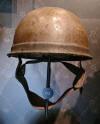
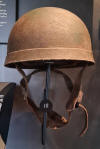
_small.JPG)
_small.JPG)
From left to
right:
HSAT "P" or "Bruneval" helmet in the
Airborne Museum at the Hartenstein
in Oosterbeek, the Netherlands;
HSAT helmet with fiber rim at the
Hartenstein;
HSAT MkI helmet at the Hartenstein;
HSAT MkII helmet at the Ciney,
Belgium military show |
Royal Armoured Corps Helmet
This combat helmet was worn by
Armoured Troops. As with the
similarly shaped HSAT, it was
initially manufactured by BMB. It
was introduced in WW2 and was issued
to commonwealth countries in the
post-1945 era up to the Falklands
War. The RAC helmets came with the
same suspension and liner from the
Brodie helmets and later the
elastisized suspension and liner
from the MkIII helmet. Many were
converted to be used as a Paratrooper
Helmet.
Telltale signs for this type of
helmet are:
- the hole in the top of its dome to
allow the liner to be bolted into
it;
- the riveted swivel bale
attachments for the fabric chinstrap
at the 3 and 9 o’clock positions.
|
|
(click to enlarge)
_small.JPG)
_small.JPG)
_small.JPG)
_small.JPG)
_small.JPG)

From left to
right:
Six images of a RAC helmet from
the private collection of Battle
Detective Wilbert
Note screw hole in apex of the
helmet
RAC troopers wearing tanker
helmet in Holland Spring 1945 |
Despatch Rider Helmet
This helmet was introduced after it
was determined that the old
paper-pulp motorcycle helmet was not
safe enough. The army used the
existing rimless parachutists helmet
shell and coupled this with a new
liner to make it suitable for use on
a motorbike. The distinctive feature
of the helmet is the leather
"curtain" that goes around the neck
and under the chin.
Telltale signs for this type of
helmet are the small rivets for
attaching the padded liner at the
10, 2, 5 and 7 o’clock positions;
hence no holes at the 6 o’clock
(neck) position.
|
|
(click to enlarge)

_small.JPG)
_small.JPG)

From left to
right:
Two despatch rider helmets at the
Ciney, Belgium military show
Despatch rider helmet on sale on
eBay
Despatch rider laying his head to
rest in his helmet |
Description of the Oude
Stadsgracht Helmet
On 17MAY2022 the restoration expert
of the BAAC company reported on his
work:
"The helmet shell isn't magnetic
anymore and has been impregnated
[with preservation material]. Also,
I have been able to make the
original colors visible again. The
helmet has been painted over a
number of times. Very remarkable is
the Dutch flag which is painted on
one side. On the rear a black
surface became visible. Something
might have been written on it,
perhaps a chalked number?
I suspect that we are dealing with a
British (Canadian is possible as
well) despatch rider helmet; you
might say a motor cycle courier.
Because of the painting it is very
special."
That same day an
article about
the discoveries in the old moat
was published in the Eindhovens
Dagblad daily newspaper.
Judging from the two rivets on the
side of the helmet we agree with the
restorer that we are
dealing with a despatch rider
helmet. We again asked to be allowed
to see the inside of the helmet. |
Exhibits:
Finally, on 08AUG2022 we visited the
BAAC company's office and were able to hold and photograph the
British despatch helmet together with the
German M40 helmet found in the same Oude Stadsgracht moat.
We saw that the helmet features the
rivets on the inside typically of
despatch rider helmets.
The painted Dutch flag make this
helmet and how it ended up in the
old moat, an unsolved mystery.
Did it belong to a dispatch rider of
Dutch descent or a member of the
Royal Dutch Princess Irene Brigade
who arrived in Eindhoven after
18SEP1944 as part of 30th Corps?
Was the flag painted on the helmet
after the liberation of Eindhoven?
Did it end down in the moat during
the 19SEP1944 bombing raid of the
city by the German Luftwaffe?
Our readers are encouraged to share
their thoughts on the possible
background of this remarkable Battle
Relic. |
|
(click to enlarge)
_small.JPG)
_small.JPG)
_small.JPG)
_small.JPG)
The helmet photographed from all
sides
Note Dutch national flag on side and
black square on front
_small.JPG)
_small.JPG)
_small.JPG)
The telltale rivets on the inside
leave no doubt that this is a
despatch rider helmet
_small.JPG)
_small.JPG)
_small.JPG)
The German M40
helmet which was also found in the Oude Stadsgracht moat |
Origin and route of helmet?
To which unit did the wearer of the
helmet belong and how did it end up
in a moat in Eindhoven?
Dwayne, Conflict Archeologist / KNA-
Materials Specialist at BAAC wrote
to this agency:
"Now, the flash [the black
rectangular painted mark on the
helmet] appears to have the
number '111' applied on it. It seems
possible to me that we are dealing
with a flash of the HQ of the 2nd
Battle Group of the [Dutch]
Princess Irene Brigade. Therefore,
my colleague’' theory that it is a
helmet were a flag was painted on
for a victory parade, seems
illogical to me. "
Dwayne went on to wonder how a
helmet of the Princess Irene Brigade
ended up at this location in
Eindhoven assuming that it was lost
by the wearer during the 19SEP1944
Luftwaffe bombing raid on the city.
The Princess Irene Brigade arrived
in town not before 20SEP1944.
We, in turn, informed him that the
Princess Irene Brigade used the
British color coding system for
vehicle markings in 1944.
We provided Dwayne with an analysis
of tactical vehicle markings of the
unit on (black and white)
photographs taken in the Netherlands
in the last years of World War Two.
|
|
(click to enlarge)

British tactical
markings on Dutch Princess Irene
Brigade vehicles in the Netherlands
1944 – ’45 |
A marking with '111' would have been
painted on a red triangular
background. We had never seen these
markings painted on helmets. But
that applies to the little Dutch
flag as well and therefore nothing
can be ruled out in this matter.
In theory the helmet may have
belonged to a point man in the 2nd
Battle Group who arrived in
Eindhoven days before the Brigade
crossed the Belgian border on
20SEP1944. It is not impossible that
the helmet ended in the moat after
19SEP1944. It was filled in years
after the bombing raid allowing for
objects to be discarded in it just
as the German helmet found nearby.
Online Dwayne had found a document
in which Brigade HQ markings are
indicated with a black rectangle and
a photo showing a Princess Irene
Brigade dispatch rider with a
vehicle marking with '109' painted
on his DR helmet. |
|
(click to enlarge)

Princess Irene Brigade dispatch
rider of Brigade HQ in The Hague
1945. Note ‘109’ on helmet and
motorcycle fuel tank |
Dwayne: "I think that the PIB
hypothesis is the most logical so
far. "
We agreed that the photo proves that
vehicle marking have indeed been
painted on DR helmets.
We found that that ‘109’ refers to
Brigade HQ whose vehicle marking had
a black background: |
|
(click to enlarge)

Dutch Princess Irene Brigade
tactical markings in color
(Decals to be applied on scale
models) |
Because of the number '111' we
advised conducting a paint analysis
with the use of a stereoscopic
microscope or a pyrolysis gas
chromatography to establish if the
black background has always been
black or of it may have been red
originally.
Dwayne let us know that the "…
paint really seems to be black
although some types of paint can be
discolored by acid in the soil.
Therefore it may as well have been
red. Due to the preservation process
I do not think it is possible to
establish the original color or to
conduct a chemical analysis…"
Therefore the origin and route of
this battle relic remains a mystery.
|
CONCLUSION
The painted Dutch flag and the
rectangle with "111" on it, make this
helmet and how it ended up in the
old moat, an unsolved mystery.
Did it belong to a dispatch rider of
Dutch descent or a member of the
Royal Dutch Princess Irene Brigade
who arrived in Eindhoven after
18SEP1944 as part of 30th Corps?
Was the flag painted on the helmet
after the liberation of Eindhoven?
Did it end down in the moat during
the 19SEP1944 bombing raid of the
city by the German Luftwaffe?
Our readers are encouraged to share
their thoughts on the possible
background of this remarkable Battle
Relic. |
UPDATE 07OCT2022
The despatch rider helmet, along
with the German helmet and other
relics dug up during the city's
maintenance works were on display in
the Sint Catharina Kerk church in
the center of Eindhoven in September
2022.
We went inside the church and
examined the display about military
heritage in Eindhoven's
"subterranean archive":
|
|
(click to enlarge)
_small.JPG)
_small.JPG)
_small.JPG)
_small.JPG)
_small.JPG)
_small.JPG) |
|
The Municipality of Eindhoven also
issued a brochure about this relic,
the German helmet and military
heritage found in the city's soil in
general. |
|
(click to open)
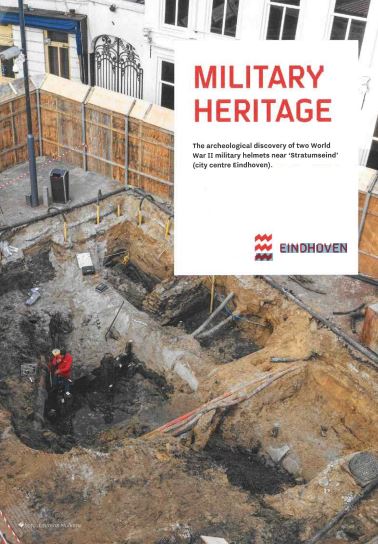 |
|
 |
|
Back to Battlerelics
 |
|
|


